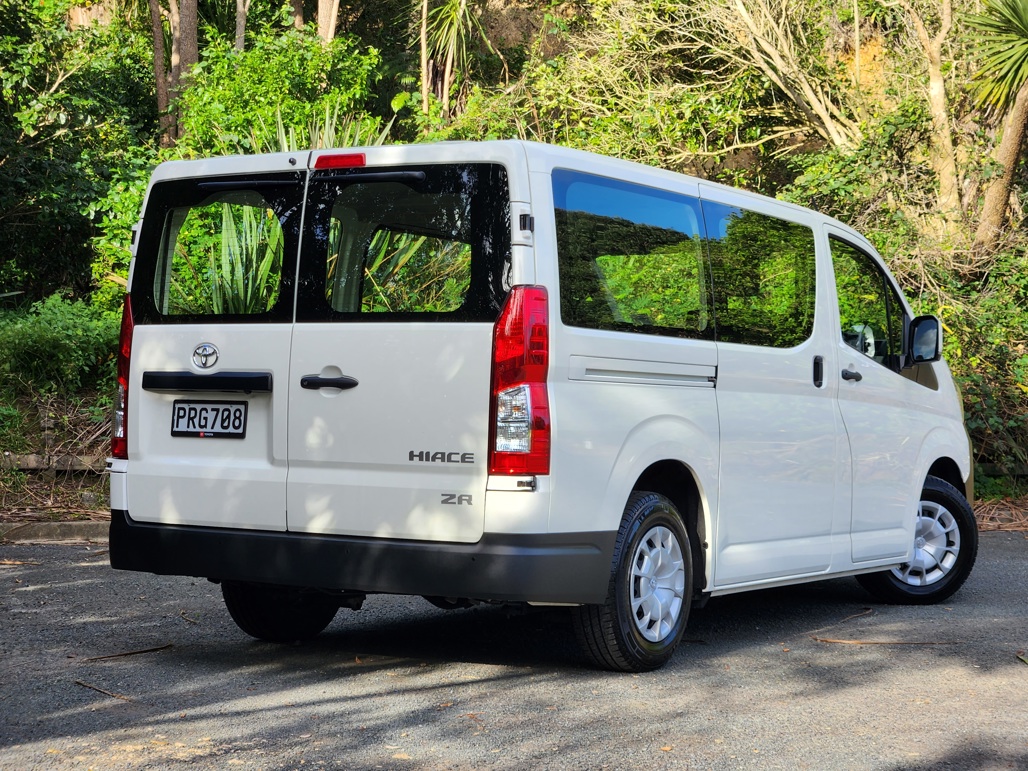Let’s just get this out of the way up front: I love vans. Vans are awesome and I would certainly rather own a van over a ute.
There, I said it. Yes, I know I’m weird.
But there is a lot to backup all of my statements when you consider it. And when you drive a modern van.
While it may have been a background character in Toyota’s stretch of dominant sales success in New Zealand, the Hiace has been a key one. And that is probably down to one simple fact - it is a Toyota.

The reputation of stoic reliability the Toyota name brings is even more valuable in the LCV segment than it is in the passenger segment, and the Hiace has long delivered on that.
Yet, despite may fanboyish love for vans and the fact that it is easily one of the best-selling vans in New Zealand, I have never actually driven the current-gen Hiace. I know, I am ashamed.
The first thing I noticed about the Hiace is that how much easier it is to get into and out of than the last model.
This is thanks to Toyota dumping the cab-forward design of the old model (where the driver sits over the front axle and engine) for a cutaway layout (where the driver sits behind them), improving not only crash safety, but also massively improving access.
I was overjoyed by the engine’s diesely rattle and the veritable sea of hard plastics that greeted me in the interior.
This also means that you no longer need to clamber awkwardly over the front wheel to get into or our of the cabin, rather you simply step into it. This does mean you miss out on a decent upper body workout every time you try to get in or out, but swings and roundabouts, I guess.
Anyway, after figuring out what to do with the weird bit of metal sticking out of the key fob (apparently people used to put it in the steering column and twist it to start their cars many moons ago…) I was overjoyed by the engine’s diesely rattle and the veritable sea of hard plastics that greeted me in the interior.
I mean, of course the plastics were hard - it is a van, that means it needs to be durable - but they were also of an impressively high quality, with nothing that felt like it was going to snap off or start to rattle in the near future. Or, indeed, at all.
Nope, the interior will happily leave the rattling to the diesel engine, which is the venerable 2.8-litre four-cylinder turbo that does duty in the Hilux and, in Hiace guise, produces 130kW and 450Nm while driving the rear wheels through a six-speed automatic.
The Hiace is surprisingly sprightly when unladen, having no trouble catching non-van drivers unaware at the traffic lights, yet with none of that silly FWD scrabbling for traction. It is also almost ridiculously easy to drive and, thanks to this one being a cargo van with side windows, it also had excellent visibility.
The Hiace is surprisingly sprightly when unladen, having no trouble catching non-van drivers unaware at the traffic lights.
This is particularly important, because the current Hiace is BIG. At 5265mm long, 1950mm wide and 1990mm high it is almost as long as a Hilux, yet it is almost 100mm wider.
Of course, this translates into some impressive cargo space - 6.2 cubic metres of it in fact - with a load space that is 2745mm long and 1775mm wide (1265mm between the wheel arches) and a maximum payload of 1010kg.
As far as vans go, the Hiace is a superb option, offering up comfort, strong performance and that all-important reliability.
This particular example was one fitted with the proper doors for a van - barn doors - that can be opened to either 90 or 180 degrees, allowing for excellent accessibility to the rear. If you prefer head injuries, however, other Hiace models are available with a lift up tailgate rear opening.

The Hiace will also pull a trailer weighing up to 1500kg braked and 400kg unbraked. Thankfully, it also has ventilated disc brakes all round to handle those various weights and capacities when stopping is needed.
The Hiace also comes with Toyota’s full array of safety and driver assist systems, boasting a pre-collision system with autonomous emergency braking and pedestrian and cyclist detection, as well as lane departure monitoring, trailer sway control, blind spot monitoring, hill start assist, automatic high beam lights, road sign assist and a backing camera with dynamic guidelines and two front and four rear parking sensors.
As far as vans go, the Hiace is a superb option, offering up comfort, strong performance and that all-important reliability. It just happens to be actually great to drive too.
TOYOTA HIACE ZR CARGO VAN
ENGINE: 2.8-litre turbo-diesel inline four
POWER: 130kW/450Nm
GEARBOX: 6-speed automatic transmission, RWD
CONSUMPTION: 8.6l/100km, CO2 228g/km, Clean Car fee $5750
PRICE: $52,790













